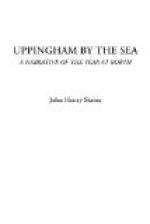Those who had brought a family with them into camp were more seriously troubled with the cares of providing quarters, and pondered regretfully on the peace and roominess of home. Still as we are leaving no one houseless or dinnerless, we may turn aside to describe at more leisure the place we lived in and the manner of our life.
The stage on which our little history was enacted is a maritime plain of irregular semicircular shape, with a sea-front of five miles, and a depth inland of from two to three miles. This plain, a dead level stretch of peat, of which part is coming under cultivation, while part is still marsh, is surrounded by a ring of hills, which rise in successive well-defined ranges of increasing height, till they culminate in the summits of Cader Idris on one side and Plinlimmon on the other.
The River Dovey, which cleaves the circle of mountains, flows in a broad estuary along the base of the northward hills, under which, at the mouths of the estuary, lies the little port of Aberdovey. At the other end of the arc formed by the coastline, close under the slopes of the promontory which closes the plain at its north-west corner, stands the village of Borth, three-quarters of a mile of straggling dwellings, which vary in scale and character from the primitive mud-cabin of the squatter to the stately hotel which formed the headquarters of the school. The little town is irregular even to quaintness, without being picturesque. Its houses are not grouped according to size and character, but dropped as it were anyhow, in chance collocations, tall and low, thatched and slated together. Two or three gigantesque meeting-houses, featureless and sombre, domineer over the roofs around them. One or two others of a less puritan design, and not out of character with the church on a knoll a furlong off, compensate their severer rivals. The shape of the village is determined by the narrow ridge of terra firma, the mere heaping of the tides, between the quaking marsh and the encroaching sea. The nidus of the present settlement is the tiny hamlet of Old Borth, perched on a spur of the promontory, and well out of reach of flood tides. We are not sure that the mother may not outlive her colony, unless substantial measures are taken to guard against another 30th of January. Near Old Borth, through a gap in the hills, comes the River Lery, a trout-stream known to our anglers, thanks again to Sir Pryse who owns it. It races bubbling round the furze-clad knoll, whose Welsh name is translated Otter’s Island, on which stands the church, and then is silenced in a blank straight-cut channel, which conveys it through the marsh into the estuary at Ynyslas. Up the gorge of the Lery runs the railway, which carried us so often past the massive church and steep pine-grown graveyard of Langfihangel-geneur-glyn, and across the broad meadows of Bow Street, to the civilisation of Aberystwith. For Aberystwith was our Capua, and used to draw large parties on many a blank afternoon for marketing or amusement.




